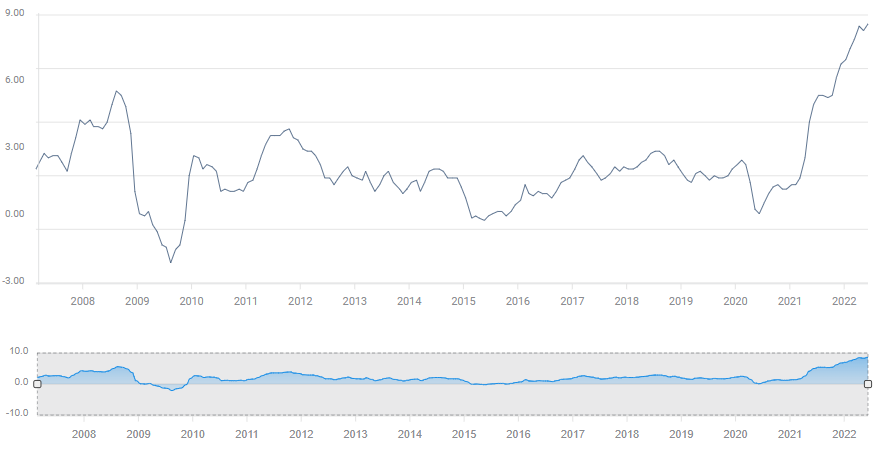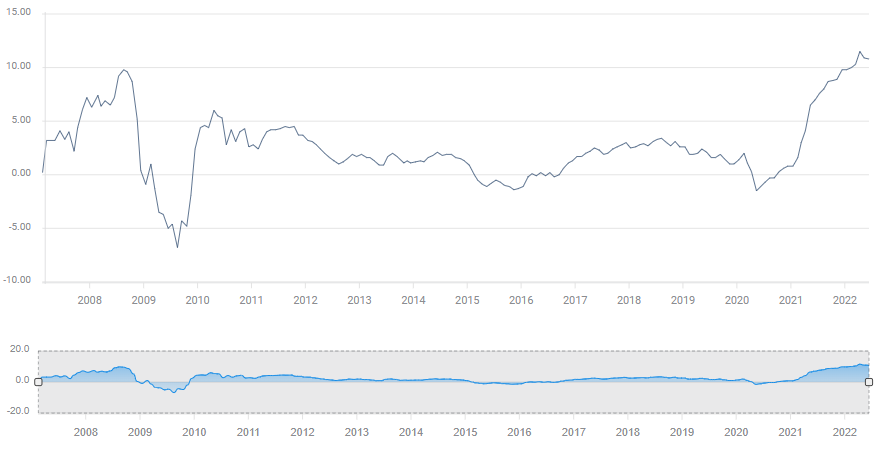- Core PCE price Index forecast to rise 0.4% MoM, 4.7% YoY in May.
- Federal Reserve will increase the base rate 0.75% on July 27.
- CPI at 1.0% MoM, 8.6% YoY and core at 0.6%, 6.0% in May exceeded predictions.
Inflation may still surprise markets but it will not change Federal Reserve policy.
The Personal Consumption Expenditures Price Index (PCE) should follow consumer inflation higher in May, though analysts have predicted a slight moderation in the annual rate. Core PCE prices are forecast to rise 0.4% in the month after a 0.3% gain in April. For the year prices are expected to increase 4.7%, down from April's 4.9%. Overall PCE prices rose 0.2% in April and 6.3% for the year.
The Federal Reserve’s official 2% target for the core PCE rate has been observed almost exclusively in the breach. From the financial crisis of 2008-2009 to the recovery of 2021, inflation was routinely beneath its goal. Since the spring of last year it has been permanently above. In the fall of 2020, the Fed changed its inflation accounting from a single target to an average. The governors intended to let prices increase faster than 2% for an unspecified period, long enough to produce an average rate around 2%.
Given the Fed’s then stated conviction that any price increases would be temporary, the policy would have obvitated any pressure to raise rates for several months of above target inflation. Prices, however, have escaped Fed control. The six-month average for core PCE prices is 5.0%, for 12 months it is 4.4%.
CPI
Consumer prices took an unexpected jump in May.
The overall Consumer Price Index (CPI) had been forecast to add 0.7 after April's 0.3% gain. Core prices were predicted to drop to 0.5% from 0.6% in April. The annual rate was expected to be unchanged at 8.3%, and the core rate was to fall to 5.9% from 6.0%. The declines were expected to confirm that price pressures had continued to ebb from March’s four-decade high of 8.5% and February’s core peak of 5.3%.
CPI
In fact, the headline 1% monthly and 8.6% annual increases and the core gains of 0.6% and 6.0% were a major shock to markets and the Fed.
The Fed’s surprise was so great that it took the highly unusual step of anonymously sourcing a Wall Street Journal article during the standard two-week comment blackout period prior to every Federal Open Market Committee (FOMC) meeting. The piece let markets know that the governors were considering a 0.75% increase. At the previous FOMC meeting on May 4, Chair Jerome Powell had all but promised a 0.5% increase.
The Fed duly hiked 75 basis point to a 1.75% upper target. Market expectations for the July 27 FOMC moved in accordance and are now 89.1% for a second 75 point increase.
PPI
The Producer Price Index (PPI) that tracks inflation in the manufacturing process moderated in May. Overall, prices rose 0.8% on the month as expected and at 10.8% were slightly softer on the year. Core prices added 0.5% on a 0.6% forecast and 8.3% annually on an 8.6% supposition.
PPI
FXStreet
While annual price increases have fallen from their all-time March records of 11.5% and 9.6% for core they are still considerably higher than consumer inflation, making further retail increases likely as producers pass on the remainder of their own expense escalation.
WTI and gasoline
West Texas Intermediate (WTI) the North American crude oil pricing standard rose 10.2% in May. Opening at $103.44 on May 1, the finish at $114.04 all but guarantees price increases throughout the economy. Oil is the world's most ubiquitous commodity. It is present in some fashion in almost every product or service of a modern economy.
WTI
The nationwide cost of a gallon of regular gasoline rose 10.6% in May.
Conclusion: Inflation is passe
Federal Reserve policy is set through the July 27 FOMC meeting and very likely through the end of the year.
If the governors add another 75 basis points this month bringing the upper target to 2.50%, it will still require another 100 points over three meetings to reach the Fed’s own projection of 3.4% at the end of the year.
In a real sense inflation is now moot. Higher-than-expected PCE results will only reinforce Fed policy. Lower than forecast inflation will still leave price increases so far above Fed’s goals, that a year of further increases is the default assumption.
The risk of a recession from the combination of an inflation-induced consumer pullback and a slowdown in rate sensitive sectors is the chief threat to markets. Second quarter GDP is reported on July 28, one day after the Fed meeting. The Atlanta Fed’s latest estimate is 0.3%.
Will a negative print for the second quarter, and a traditional if not official recession, dissuade the Fed?
Information on these pages contains forward-looking statements that involve risks and uncertainties. Markets and instruments profiled on this page are for informational purposes only and should not in any way come across as a recommendation to buy or sell in these assets. You should do your own thorough research before making any investment decisions. FXStreet does not in any way guarantee that this information is free from mistakes, errors, or material misstatements. It also does not guarantee that this information is of a timely nature. Investing in Open Markets involves a great deal of risk, including the loss of all or a portion of your investment, as well as emotional distress. All risks, losses and costs associated with investing, including total loss of principal, are your responsibility. The views and opinions expressed in this article are those of the authors and do not necessarily reflect the official policy or position of FXStreet nor its advertisers. The author will not be held responsible for information that is found at the end of links posted on this page.
If not otherwise explicitly mentioned in the body of the article, at the time of writing, the author has no position in any stock mentioned in this article and no business relationship with any company mentioned. The author has not received compensation for writing this article, other than from FXStreet.
FXStreet and the author do not provide personalized recommendations. The author makes no representations as to the accuracy, completeness, or suitability of this information. FXStreet and the author will not be liable for any errors, omissions or any losses, injuries or damages arising from this information and its display or use. Errors and omissions excepted.
The author and FXStreet are not registered investment advisors and nothing in this article is intended to be investment advice.
Recommended Content
Editors’ Picks

EUR/USD stays near 1.0400 in thin holiday trading
EUR/USD trades with mild losses near 1.0400 on Tuesday. The expectation that the US Federal Reserve will deliver fewer rate cuts in 2025 provides some support for the US Dollar. Trading volumes are likely to remain low heading into the Christmas break.

GBP/USD struggles to find direction, holds steady near 1.2550
GBP/USD consolidates in a range at around 1.2550 on Tuesday after closing in negative territory on Monday. The US Dollar preserves its strength and makes it difficult for the pair to gain traction as trading conditions thin out on Christmas Eve.

Gold holds above $2,600, bulls non-committed on hawkish Fed outlook
Gold trades in a narrow channel above $2,600 on Tuesday, albeit lacking strong follow-through buying. Geopolitical tensions and trade war fears lend support to the safe-haven XAU/USD, while the Fed’s hawkish shift acts as a tailwind for the USD and caps the precious metal.

IRS says crypto staking should be taxed in response to lawsuit
In a filing on Monday, the US International Revenue Service stated that the rewards gotten from staking cryptocurrencies should be taxed, responding to a lawsuit from couple Joshua and Jessica Jarrett.

2025 outlook: What is next for developed economies and currencies?
As the door closes in 2024, and while the year feels like it has passed in the blink of an eye, a lot has happened. If I had to summarise it all in four words, it would be: ‘a year of surprises’.

Best Forex Brokers with Low Spreads
VERIFIED Low spreads are crucial for reducing trading costs. Explore top Forex brokers offering competitive spreads and high leverage. Compare options for EUR/USD, GBP/USD, USD/JPY, and Gold.


